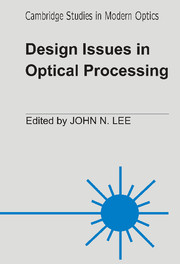Book contents
- Frontmatter
- Contents
- List of Contributors
- Preface
- 1 How optical computers, architectures, and algorithms impact system design
- 2 Noise issues in optical linear algebra processor design
- 3 Effects of diffraction, scatter, and design on the performances of optical information processors
- 4 Comparison between holographic and guided wave interconnects for VLSI multiprocessor systems
- 5 High speed compact optical correlator design and implementation
- 6 Optical and mechanical issues in free-space digital optical logic systems
- Index
Preface
Published online by Cambridge University Press: 20 October 2009
- Frontmatter
- Contents
- List of Contributors
- Preface
- 1 How optical computers, architectures, and algorithms impact system design
- 2 Noise issues in optical linear algebra processor design
- 3 Effects of diffraction, scatter, and design on the performances of optical information processors
- 4 Comparison between holographic and guided wave interconnects for VLSI multiprocessor systems
- 5 High speed compact optical correlator design and implementation
- 6 Optical and mechanical issues in free-space digital optical logic systems
- Index
Summary
The design of optical hardware for signal and image processors and in computing systems can be expected to become an increasingly important activity as optics moves from the laboratory to actual usage. Over the past decades a variety of concepts have been developed to exploit the capabilities of optics for ultrahigh-bandwidth and massively-parallel processing such as for analog front-end operations, image-processing and neural-net applications, high-bandwidth interconnection of electronic systems such as computers and microwave subsystems, execution of logic and other nonlinear operations for routing of optical interconnects, as well as for general reduction of hardware size, weight and power consumption. Original concept investigations usually identify theoretical advantages of performing various tasks with optics, but one then needs to address whether the advantages can be maintained as one addresses various new issues involving usage in a real-world environment; e.g., can demonstrations of optical processing speed and parallelism, optical routing, and communication bandwidth be retained in full-scale application? Addressing these questions very often requires an optical approach that employs different algorithmic/architectural approaches than conventional alternatives; hence, new architectures are devised to utilize maximally the strengths of optics. Finally, the capabilities of optical technology may dictate specific optical hardware designs.
It is therefore difficult to predict whether a specific optical hardware configuration will still possess the originally identified advantages. Although full-scale demonstrations can provide a direct answer, careful design and analyses must be performed to ensure an effective demonstration. The design and analysis stage can involve fundamental issues that are quite removed from the original optical-processing concept.
- Type
- Chapter
- Information
- Design Issues in Optical Processing , pp. xiii - xviiiPublisher: Cambridge University PressPrint publication year: 1995

